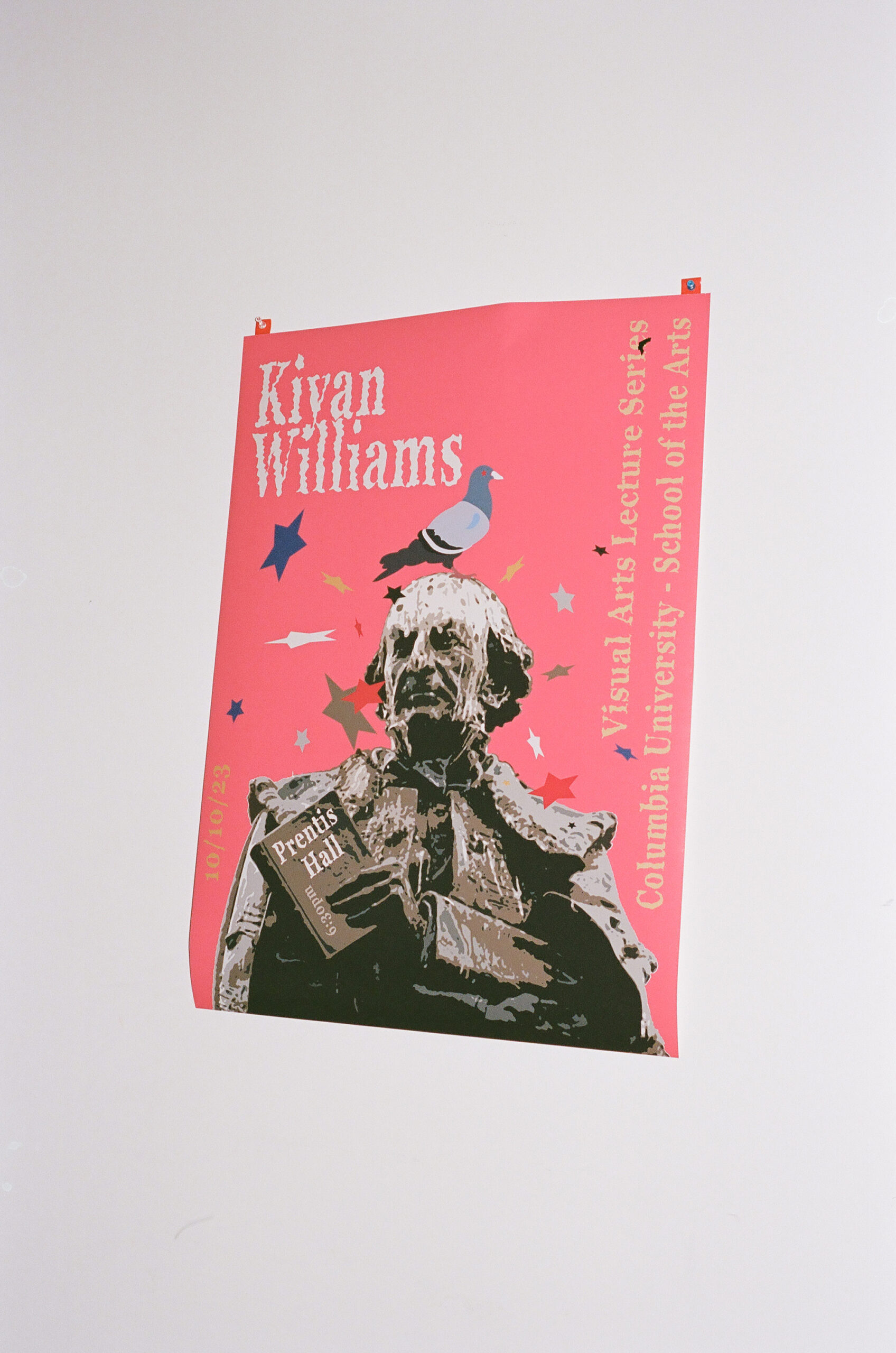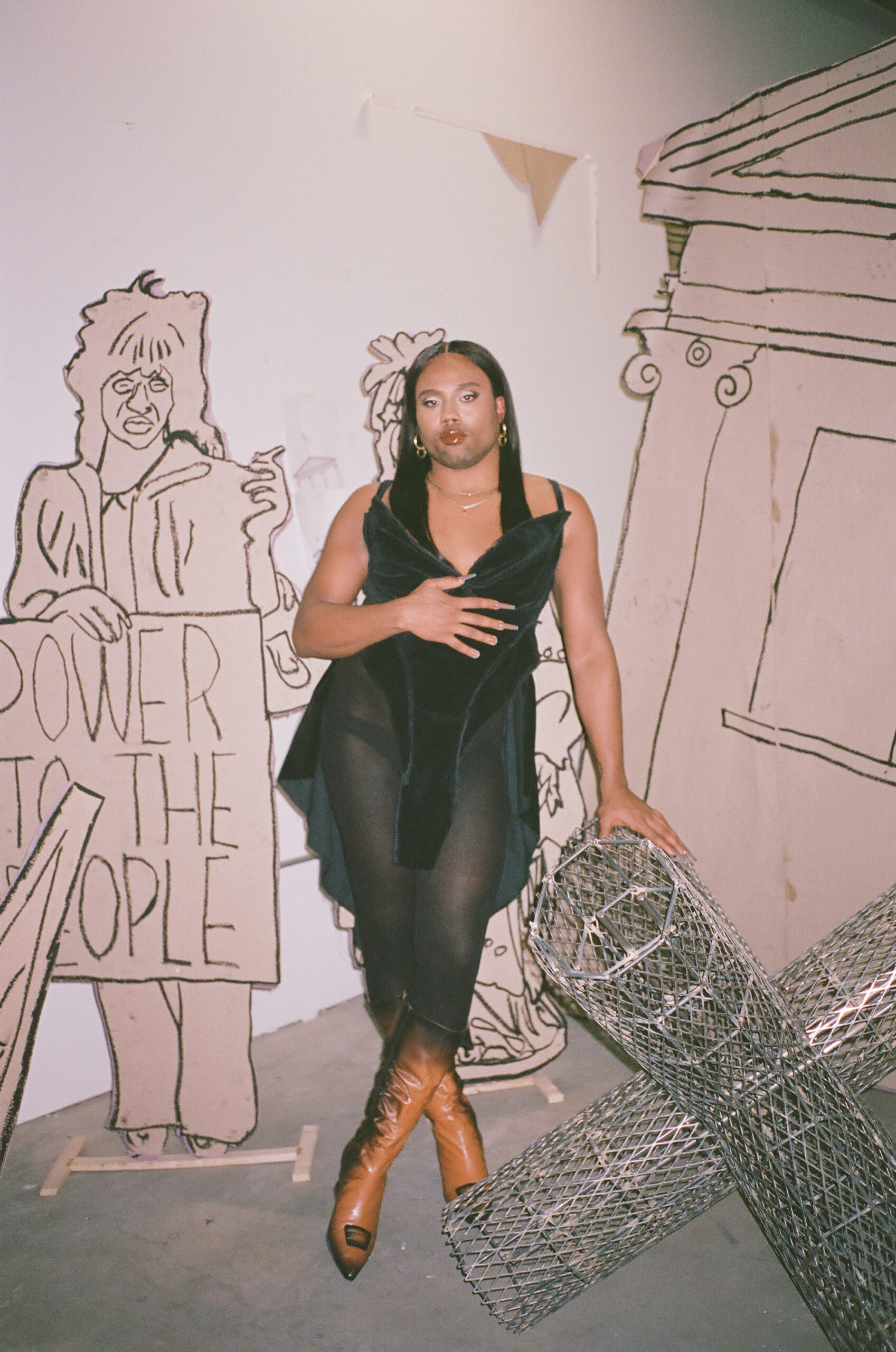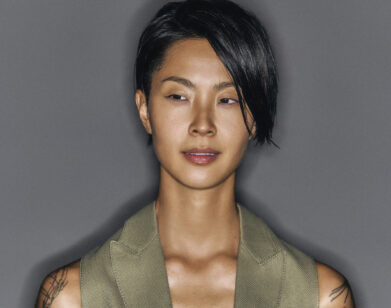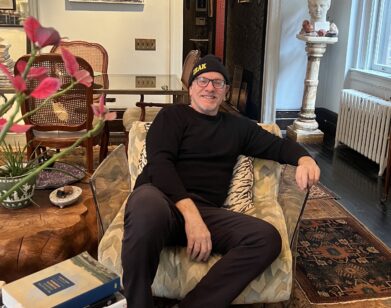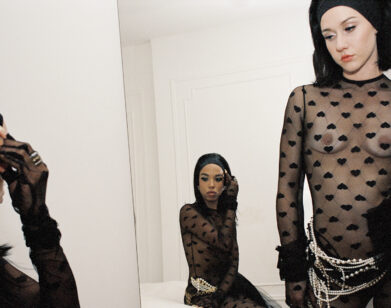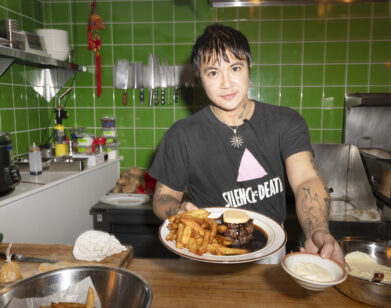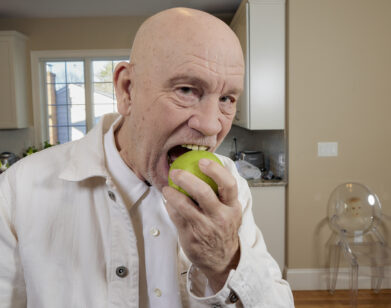ART
Kiyan Williams Is Deep Frying the American Flag
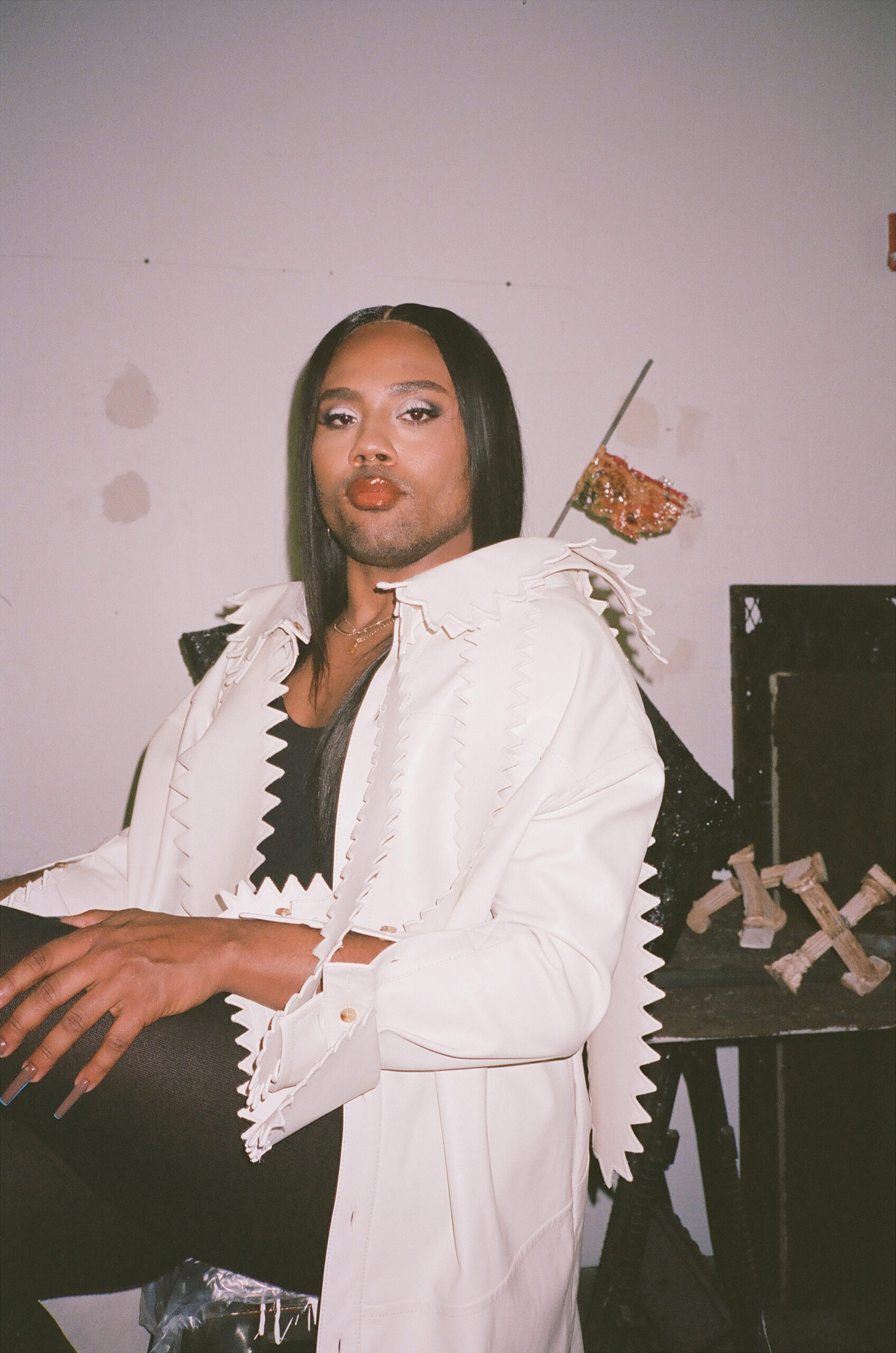
Kiyan Williams wears Coat Bottega Veneta. Bodysuit Stylist’s Own. All Jewelry (worn throughout) Kiyan’s Own. Tights (worn throughout) Falke.
The New York-based artist doesn’t shy away from tackling our most sacred cultural symbols; spinning, slanting, and altogether refashioning them until they transform into subversive monuments with audacious alternate meanings. This March, Williams is unveiling two new sculptures in the Whitney Biennial. To celebrate the occasion, fellow renegade sculptor Hugh Hayden dropped by Williams’ studio in the Brooklyn Navy Yard, looking to talk shop and learn the recipe for deep-frying the red, white, and blue.
———
WEDNESDAY 8 PM DEC. 20, 2023 NYC
KIYAN WILLIAMS: Do you want to take your coat off? Get comfortable. This is my studio.
HUGH HAYDEN: So this is where you fry your flags. For recent work, you’ve been putting American flags in a deep fryer. Are the flags dark meat or white meat? What’s the material?
WILLIAMS: They’re made of nylon. The large ones are decommissioned. They were flown at the Capitol at some point.
HAYDEN: There’s a whole industry that revolves around selling decommissioned flags. I didn’t know you could buy ones that were flown at the Capitol.
WILLIAMS: During my junior year in high school, I interned as a Congressional page for the House of Representatives. I used to raise the flag in the morning at the top of the Capitol and then lower it at night at the end of the congressional session. That flag was probably 10 feet wide. They don’t sell that one. But they do sell the smaller ones. It comes with a little certificate of authenticity.
HAYDEN: I would think different flag fabrics would have different melting properties.
WILLIAMS: They do. Nylon has a higher melting point than cotton. So in terms of frying it, I can heat it up to a higher heat point and really get the thick crust.
HAYDEN: Growing up in Dallas, it reminds me of chicken-fried steak. That’s a piece of steak that’s fried like chicken. They tenderize the meat with this thing that looks like a rototiller. Essentially like veal scallopini but not as fancy.
WILLIAMS: I’ve double-battered flags before to create a thicker crust, which abstracts and obscures the fabric and symbols.
HAYDEN: Have you ever used cornmeal?
WILLIAMS: I have. I got that recipe from my grandmother, who uses it for catfish. I use paprika for the seasoning because it creates this great color. I think of the seasonings as pigment.
HAYDEN: Do you remember there was a guy who did an art performance with a deep-fried saxophone?
WILLIAMS: Oh yeah. I also remember when I first saw the David Hammons carpet with the fried chicken wings on it [“Flying Carpet,” 1990]. And then there was his chain piece, where it’s two chains with two chicken wings attached to it, pinned to the wall. And I feel like seeing that work opened up the possibility of what art can be. By taking materials from your everyday life and transforming them and bringing them into a creative practice.
HAYDEN: When I see your fried flags, I feel like it’s a piece of meat for someone to eat.
WILLIAMS: It would be a very processed meat. This is like the McDonald’s version.
HAYDEN: You could open up a restaurant.
WILLIAMS: I do think a lot about the act of frying, about the fabrication process and what it means outside of its social context—coating and encrusting the flag in flour and egg and seasoning it for pigment and then having this bubbling surface. This is just a fabrication process. Like a process through which to achieve a certain texture.
HAYDEN: I would love it if you chicken-fried a sculpture in bronze and put it outside so the birds and rats could eat it. I can also see you chicken-frying a handgun. But, that’s just because I recently made a gun.
WILLIAMS: I’m always experimenting.
HAYDEN: I bet your long fingernails are very functional at deep-frying.
WILLIAMS: They are very functional. Like tongs, tweezers.
HAYDEN: How often do you get them done?
WILLIAMS: Maybe once a month. They’re acrylic with a coat of gel on top. They feel like extensions of my hand. I use them a lot when I’m welding because I can touch hot metal without getting burned.
HAYDEN: We already mentioned Hammons. But when you were starting out, who were the artists that inspired you?
WILLIAMS: I got into contemporary art in college through the works of Ana Mendieta, Beverly Buchanan, and Pope.L. Those were artists with a deep understanding of material knowledge and who weren’t afraid to make a mess of conventional ways of being in the world. They inspired me to think about how materials and objects play with history and power.
HAYDEN: I see there’s a model in your studio of your piece for the Whitney?
WILLIAMS: Yeah. The final piece is going to be 15 feet high. I’m showing it outside on one of the museum’s terraces.
HAYDEN: What’s it made out of ? It looks like soil, but shinier.
WILLIAMS: It is soil. It’s a new recipe I’m using in some of my earth sculptures. I’ve made the soil metallic, like chrome, by adding a layer of silver nitrate.
HAYDEN: So it’s like a mirror.
WILLIAMS: Exactly. A blurry mirror. I think of it as the visual language of ruination. I like the metallic quality because it evokes alchemy and minerals. Sometimes it looks like it’s welded on, which is really cool, and yet it’s still part of the language of materials that come out of the earth.
HAYDEN: Where are you getting the soil from?
WILLIAMS: Oh, you’re trying to get all my recipes. [Laughs]
HAYDEN: Well, different soils have different mineral content.
WILLIAMS: That’s true. The soil here is from New York. But for the final project, I’m sourcing earth from a quarry in Virginia, which is the same place the materials used to build Washington, D.C. were sourced. Materials evoke a specific geography or landscape. I think about the earth as an alternative archive, telling a different history of a place that isn’t just representational.
HAYDEN: Have you ever gotten materials from construction sites? Where they unearthed those slave burial grounds in Lower Manhattan, I can picture you down there with a shovel.
WILLIAMS: I did that in grad school. I took stuff from construction sites around Columbia. I gathered up the bricks of residential buildings, and made a piece out of them for my thesis show. I’d also collect the earth, because they did half the work for me by digging up these huge amounts of it.
HAYDEN: You’re molding the soil into octagonal columns. Is sourcing the soil from Virginia then a reference to the White House or Monticello?
WILLIAMS: Both. Because Monticello references the White House in terms of its facade—specifically, the portico of the north facade of the White House. It’s government architecture with similar origin stories. I’m tilting it 15 degrees to destabilize the structure so that it looks off balance. People can walk around it and in it. It’s essentially a building.
HAYDEN: Say if Gordon Matta-Clark cut it in half, would you see anything inside it?
WILLIAMS: You won’t see the interior. It’s a wall, but also the ruins of a wall. So there will be the relief of a window, but not an actual window you can see through.
HAYDEN: So the front facade is like makeup. It looks like the work of an alchemist.
WILLIAMS: I feel like that’s what making sculpture is. It’s just transforming material.
HAYDEN: You’re also making a piece on Marsha P. Johnson for the Whitney, right? Is she going to have the same treatment?
WILLIAMS: No, she’s going to be polished aluminum. She’s casted. I made a 3D model referencing archival images, but I cast my own hands and included it on the model to get details of the skin. Because those are really the only parts of her skin you see, the face and hands. It’s my first cast-metal piece.
HAYDEN: What is the base going to be like? Because it seems like it’s a human scale.
WILLIAMS: There’s going to be earth around it so that it looks like there’s a seamless transition from the earth to the sculpture. Most monuments are on a pedestal. She will be on the ground.
HAYDEN: But these are monuments too.
WILLIAMS: Subversive monuments. She’s smoking a cigarette. She’s like an everyday around-the-way girl. She’s like me and my friends.
HAYDEN: I would love it if the wall text read, “And the artist invites you to smoke a cigarette out on the terrace.”
WILLIAMS: They probably wouldn’t allow that at the Whitney. We did that at my show in Milan because there were balconies in the gallery.
HAYDEN: In Milan, you also showed these free-standing columns in the form of X’s. What does that symbolize?
WILLIAMS: The column X’s take the literal structures that support government buildings and collapse them into themselves. To suggest the fragility, the malleability of structures and symbols of power, hegemony, and empire. The X’s also…well, under the Roman order, columns represent the notion of an idealized body and the perfect proportions of a cis man and a cis woman’s body. So, collapsing them into the X is breaking that meaning to form a symbol for the unknown, the un- knowable. And the X is the marker for gender-nonconforming identity. It’s all of it, collapsing different forms of meaning.
HAYDEN: Would you ever make any of the columns prostrate, like limp? I once made an anthropomorphic life-sized wooden cross that was slouched over with a penis.
WILLIAMS: You love sneaking a penis into a work. Why?
HAYDEN: Well, it gives it a gender. Also people can look at it in this anthropomorphic place. Crucifixes usually show Jesus with a loincloth. In reality, if someone was being humiliated, tortured, and killed, they would have been nude. But people choose to erase that.
WILLIAMS: Right. You could also just say you like penises.
HAYDEN: I don’t know if that’s the driving force around it. My current show has a lot of penises in it. It’s about masculinity. I had read this article about how there was an episode of Euphoria that was supposed to have some absurd amount of penises. It got cut down but, it still had 30 penises in it. I do find it interesting when things are so talked about. It’s just interesting, people’s reaction to things.
WILLIAMS: That’s what it means to be an artist. You have to give the thing up to the public. You have your intentions, your ideas, but then it becomes art when other people cre- ate their response to it.
HAYDEN: Yeah. The more I mature as an artist, the more I get away from talking about my work.
WILLIAMS: Exactly. I’m taking symbols that have an inherent meaning. Then through the process of material transformation and fucking with the form, remixing them, people have to engage and dissect and decode on their own terms.
———
Hair and Makeup: Demi Washington.
Fashion Assistant: Nikael Cheek.
Production Assistant: Azra Schorr.

